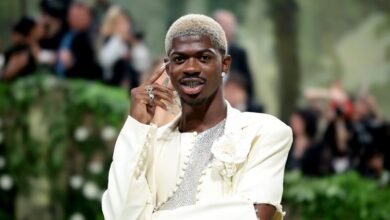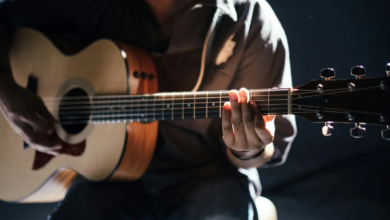Riffs and Remedies: Exploring Karen Haglof’s Musical Renaissance in new album ‘One Hand Up’”

Karen Haglof is a multifaceted artist whose career spans across music and medicine. Starting her musical journey in the rich indie rock scene of Minneapolis, she played alongside iconic acts like the Replacements and Husker Du before moving to Manhattan. There, she joined the avant-garde ensemble of Rhys Chatham and the Band of Susans, contributing to New York’s vibrant music culture. Her creative path took an intriguing turn when she left music to pursue a medical degree, eventually specializing in hematology/oncology at New York University Hospital, where she served until her retirement in May 2023.
Despite a hiatus from music, Karen’s passion reignited in 2014 while she was still a practicing oncologist. She returned to the music scene with her album Western Holiday, followed by Perseverance and Grace, the Palomino Steady Rocking EP, and Tobiano. Her latest album, One Hand Up, due out June 14, 2024, reflects a blend of musical styles, showcasing her guitar skills and inventive songwriting. The album features tracks like “Slinky 66,” inspired by the pandemic, and “Club 2121,” a nod to futuristic jazz. One Hand Up not only highlights her mastery of the guitar but also integrates visual art, with songs accompanied by animations and video clips, marking her continued evolution as a creative force.
Congratulations on your fourth full-length album, One Hand Up. Can you tell us about the journey of creating this album and how your background in music and medicine influenced it?
The tracks on One Hand Up certainly are an exploration of and casual disregard for musical boundaries; the songs are not strictly folk, rock, Americana, prog, funk, disco, avant, country, or pop, but do draw freely from all. It definitely represents a “no holds barred” approach. Hence the title, One Hand Up, like a bronc rider!
I had some music planned for 2021, but the 2020 pandemic dramatically changed the medical and musical ecosystem; patients were lost, plans put on hold, or abandoned.
On New Year’s Day 2021, I put out a single, “Devastation Completed,” in hopes that the pandemic devastation of 2020 HAD been completed; I was premature in that thinking. On “Devastation Completed,” I was the writer/producer; Mario Viele and I created the drum loop and added sub-bass and acoustic guitar, and CP Roth played normal bass and Hammond. The vocals were highly processed. Mitch Easter added MOOG and mixed. I could imagine the visuals clearly, as part of an action movie closing credits scroll….or the closing credits of a pandemic.
That track really does mark the beginning of the directions produced in One Hand Up. Mario and I continued in the same vein of exploration, drawing on loops and found sounds, interesting time signatures, and tempo shifts. This was at least in part driven by starting to create 2d hand-drawn animation; as I was writing music, visuals formed. I worked on the material with Mario and CP Roth, as the project might demand. A loose, experimental vibe prevailed. Once we had enough material, we picked the tracks for One Hand Up, some mixed by Mitch Easter, some by Mario Viele, and some produced by me and Mario.
With those influences and experiences, I developed a greater focus on rhythmic overlays, overtones, and nonstandard tunings.
The album features a rich blend of sonic elements. Could you discuss your approach to guitar playing on this album and how you’ve developed your unique style over the years.
As a quick synopsis, my guitar journey started with guitar lessons at age 12, to Midwest cover bands, to NYC power pop/avant guitarist/culinary denizen, to a medical career. At the medical switch, I dropped the guitar and didn’t pick it up for over a decade; when I did play again, it was blues-based open tuning fingerstyle. I started putting together riffs and progressions and reached out to producer/bass player Steve Almaas for direction. That led to Western Holiday in 2014, followed by Perseverance and Grace in 2016, then Palomino Steady Rocking EP in 2018, and Tobiano in 2019.
I considered myself a standard rock guitarist until moving to NYC and working with minimalist composer Rhys Chatham and in other avant projects, and joining Band of Susans. With those influences and experiences, I developed a greater focus on rhythmic overlays, overtones, and nonstandard tunings. Those influences continue, reshaped in DADFshAD-tuned fingerstyle blues-based progressions as can be heard on prior releases as well as current. The guitar work on One Hand Up is still pretty reliant on the DADFshAD tuning, with layered tracks of riffs with droning strings and fingerstyle playing, such as in “You’re Not Where I Am” and “Day 34.” However, otherwise, I like a good progression or riff like in “D.H.Y.B.” and “Club 2121.” The guitars used on One Hand Up are mainly a Telecaster or Strat run through my old 50W Marshall head and custom Dr. Z studio speakers, dialing in the desired tone without much in the way of pedals. I used a DigiTech Whammy on parts of “BQE,” but I think that’s about it. I think my style is dependent on the song and its needs.
One Hand Up incorporates visual arts through hand-drawn animations and motion graphics. What inspired you to include these elements, and how do they complement the music?
For the longest time, I wanted visual art for my music. Around 2019, I started learning 2d animation. I began trying to put snippets of video together with the music I had in progress. Sometimes, one of the songs presented itself as a visual to me and was shaped by that visual – “Girl vs Guitar” and “One Hand Up” came about along those lines. Other times, the song is “done,” so to speak, and the visual comes about in pieces, highly dependent on my learning curve. This is the case for “Slinky 66,” “Day 34,” and “SBR Dub.” It is exciting to me to try to convey a visual as well as sonic landscape. I have no idea what the reception will be as this is not very typical animation….experimental in tone with features of found footage, manipulated footage, hand drawn animation, and the magic of the Adobe Suite.
We made loops out of clips from washing machines and hospital alarms and recreated crashes throwing stuff around the studio.
You’ve had a significant partnership with Mario Viele and CP Roth in the making of this album. How do their contributions shape the overall sound, and what’s the dynamic like when creating music together?
Mario Viele and CP Roth are two of the finest musicians and all-around good eggs that anyone could ever want to work with, and I am honored they would work with me! Mario and I have a really strong working relationship, and he is always able to translate my sonic wishes to reality through his engineering and guitar and vocal contributions. We made loops out of clips from washing machines and hospital alarms and recreated crashes throwing stuff around the studio. I can’t tell you the number of times I said, “Hey MV, what if we tried….” CP is a magician, as far as I’m concerned. I have frequently sent him a rough demo and an arcane reference (“opening credits season 2 Dynasty”) or a description of the video plan, and he has an uncanny ability to come up with the components that fit and also expand on them and bring in new and unexpected elements. CP is invaluable on keys, bass, drums and musical style and open attitude. In general, we all have a very loose dynamic, with everything open for discussion and possible reinterpretation.
“Slinky 66” sounds like a standout track with its unique origins and features. Could you dive deeper into how this song came together and the creative process behind it?
Mario and I were working on drum loops and scavenged an unreleased track that drummer Jonathan Kane played on, pulling a fill and looping that with a digital hi-hat and kick. Then I did the bass line and added a keyboard line with a syncopated marimba vibe. Lyrics came later; the guitar line was a very loose exploration, based partly on a Strat-style guitar found on the street with a Floyd Rose bridge! The body was cracked, but with a new body and some TLC, it came back to life, especially notable on “Slinky 66.” Mitch Easter added MOOG and also mixed. The vibe/song is a dreamy contemplation of travel and comfort and ease with a special someone. The animation is a psychedelic mixed media piece with layered videos and drawn animation.
In “Club 2121,” you explore some jazzy progressions. What draws you to these sounds, and how do you decide which musical directions to pursue in your compositions?
That progression came from my guitar-exploratory teenage years (Mickey Baker Jazz Chord book, anyone?), and had never found a home! Through the years, I would revisit the progression now and then, but it stayed in a jam loop. It landed when I figured out an intro/middletro/outro and bridge. I can imagine it as a future-age dancehall anthem in a club frequented by extraterrestrial characters. I wrote minimal lyrics and jazzy vocalizing for multi-terrestrial accessibility! The song feels timeless, nostalgic, and futuristic, just like jazz does to me! As for deciding the musical direction, sometimes I decide, and sometimes the song decides. I started this song as a jazz guitar riff/chord arrangement with live drums, but it felt too heavy. The song rearranged itself to a disco/dance number with synth strings harkening the past but still with a futuristic vibe. What the song decided here clearly suited; it kicks.
Coming back to music, I wasn’t looking to join someone else’s thing; I wanted to have the thing.
You’ve had a fascinating career in both music and medicine. Has your perspective on music changed after such a diverse professional journey?
When starting out, music and being a guitar player were everything; as time passed, I felt like it was not everything for me, or I for it, hence the career change. For a while, I felt medicine was overridingly important, but on coming back to music, I don’t think that’s purely the case. My perspective now is that people want and need to be happy and whole, and music is important to that, just as medicine is, and keeping people happy and whole is a tough job, no matter what angle you are coming from. Before my more-than-decade lapse in playing, I was a guitarist with no aspirations as a songwriter or solo artist. I think taking on responsibility as a doctor blunted my side-man attitude and produced a greater ease with personal creative bossiness. Coming back to music, I wasn’t looking to join someone else’s thing; I wanted to have the thing.
With such a textured musical background and having been part of influential music scenes, how do you see your role in today’s music landscape?
I don’t see myself having a defined role in today’s music landscape, which is pretty freeing! I may be an interesting outlier that can point out the possibility of a multidirectional approach to life and music. I am really happy and thankful to have been part of influential music scenes. Maybe my journey away from and back to music shows that life-direction-changing decisions can happen at any point, and creativity takes many forms. However, get a thick skin! I expect maybe all artists feel that way….
After your time away from music, what rekindled your passion for picking up the guitar again, and how did you balance this with your medical career?
I saw It Might Get Loud in 2011. Seeing and hearing Jimmy Page, the Edge, and Jack White reminded me I played guitar and made me realize I MISSED playing the guitar. I thought I’d never play in a band again, but it would be cool to learn some open-tuning fingerstyle to play a few things; I started with Vestapol and Illinois Blues. During active medical practice, medicine, of course, came first. So I had to compromise part of what may be considered the standard for a musical artist, of putting out music and playing gigs and touring in support; I have not played out live much. My performing side is highly underdeveloped; this may change now that I’m retired from medicine.
Lastly, what can your fans expect from you in the future? Are there any new projects or collaborations on the horizon?
Well, six videos are currently in the pipeline/progress for One Hand Up. They will be released over the coming months as I am the sole animator at this point! Collaboration with Mario and CP is ongoing. Robert Poss contributed some wild guitar, and drummer Jonathan Kane also laid down some tracks for future projects. I’m also now working on an EP project of five to seven songs that will be the adventures of animation characters and story arcs in development. I hope to keep this up for some time!
One Hand Up tracklisting:

One Hand Up
24 – Hour Prayer Q – Beat
Bus Driver
Slinky 66
Club 2121
Day 34
D.H.Y.B.
You’re Not Where I Am
B.Q.E.
Saddle Bronc Rider Barrel Girl Dub
V.O.G. (Existential Precariosity)
Girl vs Guitar
Seesaw Again
Rte 66 Revisited
RELATED STORY:
Interview with Karen Haglof from Music to Medicine and Everything In Between



